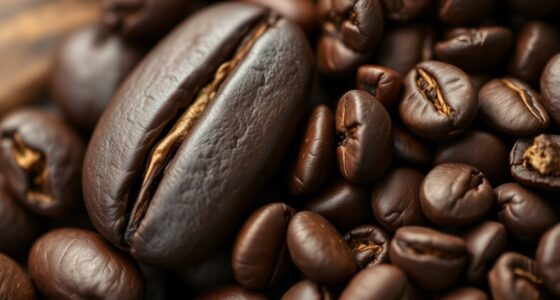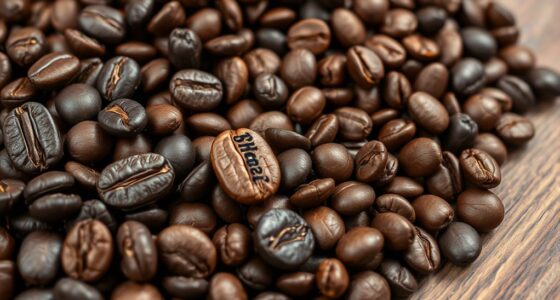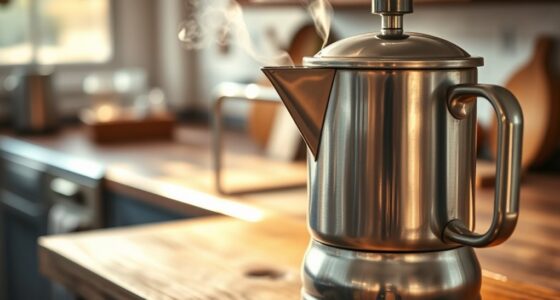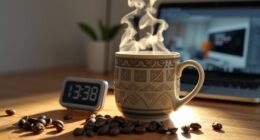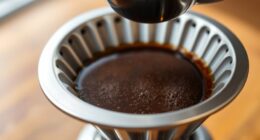To brew the perfect pour-over coffee, start by using a medium grind like sand for even extraction. Pour gently in a slow, circular motion, allowing the coffee to bloom and gases to escape. Keep your water temperature between 195°F and 205°F and aim for a brewing time of 3 to 4 minutes. Pay attention to technique and timing, and you’ll soon master how to create a balanced, flavorful cup. Keep exploring for more tips to perfect your method.
Key Takeaways
- Use a medium grind size, similar to sand, for even water flow and proper extraction.
- Start with a slow, circular pour to evenly saturate grounds and allow them to bloom.
- Maintain a consistent pour rate within 3-4 minutes total brewing time for balanced flavor.
- Keep water temperature between 195°F and 205°F to optimize extraction and flavor development.
- Practice steady pour technique and timing adjustments to refine your perfect pour-over brew.

Have you ever wondered how to brew a cup of coffee that’s rich, flavorful, and perfectly nuanced? The secret lies in understanding the fundamentals of pour-over brewing, especially when it comes to grind size and brewing time. Your grind size considerably impacts how water interacts with the coffee grounds. If it’s too fine, the water struggles to flow through, leading to over-extraction and a bitter taste. Conversely, if it’s too coarse, water passes too quickly, resulting in under-extraction and a weak, sour flavor. To get it just right, aim for a medium grind—similar to the texture of sand—which allows water to flow evenly, extracting the best flavors without bitterness or sourness.
Once you’ve got the right grind size, focus on controlling your brewing time. The duration of extraction directly influences the coffee’s taste profile. Typically, a standard pour-over takes about 3 to 4 minutes. If your brewing process is too quick, you risk under-extraction, where the coffee tastes flat and lacks depth. If it takes too long, over-extraction can occur, making the coffee bitter and overly strong. To hit that sweet spot, start by pouring slowly in a circular motion, ensuring all grounds are evenly saturated. Keep an eye on the clock, and aim for a total brewing time within the 3 to 4-minute window, adjusting your pour rate if necessary.
Your pour technique also matters. Begin with a gentle, steady pour just enough to saturate all the grounds, allowing them to ‘bloom’—a process where gases escape and the coffee expands. After the bloom, continue pouring in slow, concentric circles, maintaining a consistent flow. This method helps regulate brewing time and ensures even extraction. Remember, consistency is key; using the same grind size and pouring technique each time will help you dial in your perfect cup.
Temperature plays a role too, ideally between 195°F and 205°F. Too hot, and you risk over-extraction; too cool, and you might under-extract. With attention to grind size and brewing time, along with your pouring method and water temperature, you’ll develop a reliable process that produces a beautifully balanced, flavorful pour-over coffee every time. The more you practice, the more intuitive these adjustments become, helping you craft a cup that truly highlights the nuanced flavors of your favorite beans.
Frequently Asked Questions
What Is the Ideal Water Temperature for Pour-Over Coffee?
For the ideal pour-over coffee, you should aim for water temperature between 195°F and 205°F. This range helps extract the best flavors without over-extracting bitterness. Keep in mind, your water’s mineral content affects extraction, so use filtered water if possible. Also, guarantee your brewing equipment is preheated to maintain temperature stability. This way, you’ll enjoy a balanced, flavorful cup every time.
How Do Grind Size and Brew Time Affect Flavor?
Sure, because the secret to perfect coffee is a mystery! You might think flavor is all about beans, but your grind size and brew time play leading roles. If your grind isn’t consistent, your brew timing gets tricky, leading to sour or bitter notes. Adjusting grind size and timing helps extract the best flavors, so don’t overlook the importance of precision—you’ll enjoy a richer, balanced cup every time.
Can I Use Regular Tap Water for Pouring?
You can use regular tap water for pouring, but pay attention to water pH and mineral content. If your tap water is too acidic or alkaline, it can affect flavor, so consider testing its pH. Minerals like calcium and magnesium enhance extraction and taste, so if your water is soft or overly hard, it might impact your brew. Using filtered or bottled water with balanced mineral content can improve your coffee’s flavor.
What’s the Best Way to Store Coffee Beans for Freshness?
To keep your coffee beans fresh, proper coffee storage is key. Store your beans in an airtight container, away from light, heat, and moisture. Avoid the fridge or freezer, as temperature fluctuations can harm freshness. Instead, keep them in a cool, dark place, like a pantry. By doing so, you preserve beans freshness longer, ensuring each brew delivers rich flavor and aroma.
Are There Any Health Benefits Associated With Pour-Over Coffee?
You might notice that pour-over coffee offers health benefits like antioxidant properties, which help fight free radicals. It can also support cognitive enhancement by providing a moderate caffeine boost. When you brew this way, you retain more of these beneficial compounds because of the cleaner extraction process. So, drinking pour-over coffee not only tastes great but can also contribute positively to your overall health and mental alertness.
Conclusion
Now that you’ve mastered the art of pour-over coffee, every sip becomes a gentle reminder of your dedication. Each carefully brewed cup whispers a quiet celebration of patience and care, turning a simple morning routine into a cherished ritual. Embrace the warmth and richness you’ve created, knowing that your mindful touch transforms ordinary moments into something truly special. Here’s to many more mornings filled with the comforting glow of your perfectly brewed masterpiece.


